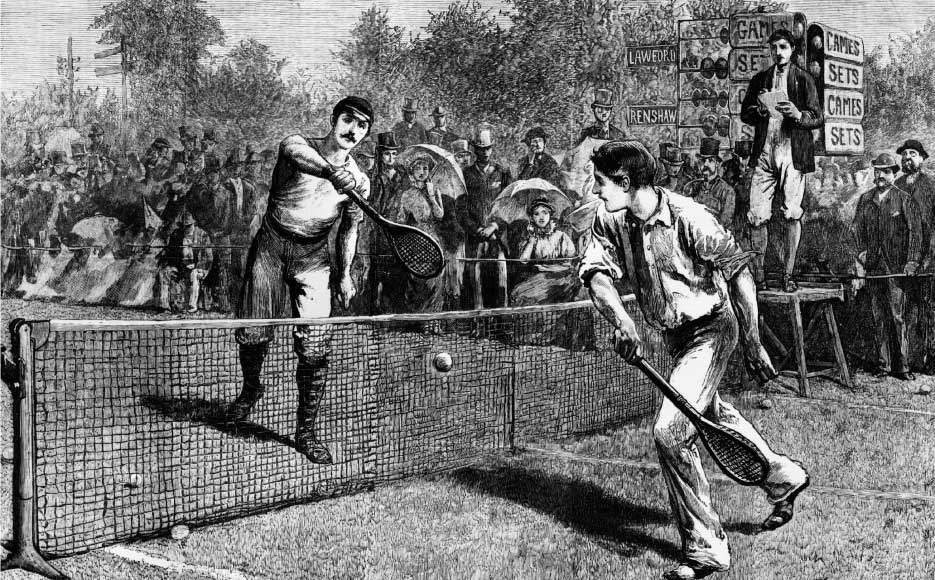What Is The History of Tennis?
A short, snugly drawn net divides two or four humans each holding a well-carved piece of wood with tightly woven webbing enclosed in a loop at the end. Each person in this recreational drama stares intently across that net at the other people, waiting expectantly to whack at a high velocity a delicately covered rubber ball with deliberate savagery. The goal? To make those on the other side incapable of striking the ball themselves with their stylishly fangled sticks.
In the early stages of this ritual – as one of the opponents fails to achieve the desired ends – someone hollers a number (10, 20 or 40) and the word “love.” The cycle then starts again. And all this is conducted within the closed confines of a high-level fence or inside a building.
We call this sport tennis. And we at Golden Ocala Golf & Equestrian Club excel at this game and at providing the wherewithal and the opportunities for our residents and guests to enjoy it.
But how did tennis start? What was its origins and how did we get what we have today? Lets delve into the history of tennis.
Tennis Dates Back Thousands of Years
Historical records are vague about the actual origins, but experts believe the game may have started thousands of years ago with ancient players in Egypt, Greece and Rome trying their hands, literally, at earlier versions of the sport.
Parsing word uses from ancient languages may point to how the game developed and its early stages. “Rahat” is the Arabic word for the palm of the hand and is similar to the English racket. “Tennis” could have come from the name of the Egyptian town of “tinnis,” according to history.co.uk.
Monks in France around 1000 A.D. reportedly played a form of the game against monastery walls or over a rope tide in a courtyard. The game became known in French as “jeu de paume,” or the “game of the hand.”
Linguistists theorize “tennis” stems from the word “tenez,” a word French monks would shout before serving the ball. The word meant “to take.”
The game grew in popularity especially among the European nobility with some historians claiming nearly 1,800 indoor courts were constructed by the 13th century.
Church Leaders Frowned on the Game
Reportedly, several leaders of the Catholic Church, including the Pope and later King Louis IV, attempted to ban the sport. The game quickly spread into England which led to Kings Henry VII and Henry VIII, both fans of the sport, ordering construction of courts.
As the sport continued to grow in popularity, indoor courts replaced courtyards and bouncier leather balls replaced wooden ones. Players also began using gloves rather than their hands and later paddles or webbing attached to a stick.
Players began using a wooden-framed racket with sheep gut and 3-ounce cork balls by the 1500s. Before the game evolved to its present form in the 1800s, tennis was played in narrow courts mostly indoors with players scoring points by hitting the balls into netted windows.
Tennis’ popularity declined in the 1700s. But Charles Goodyear’s use of rubber in the mid 1850s, which made balls very bouncy, brought a resurgence of interest in the sport and paved the way for the modern version of tennis. British Major Walter C. Wingfield, a Welsh inventor, reportedly patented the game’s rules and equipment in 1874; the first courts were built in the United States around the same time.
And the rest is history.
We at Golden Ocala Golf & Equestrian Club offer players the finest tennis amenities:
- 6 Har-Tru Hydro-Grid® Courts, all lit for night play.
- Private tennis lessons with our tennis professionals.
- Youth tennis programs.
- Champion tennis leagues.
- Tennis Pro Shop offering the latest in tennis fashion.
- Custom racket stringing.
We hope this ride through the early annals of tennis was informative and inspired you to pursue the game – even if you’re not an ancient French monk! Contact one of Golden Ocala’s tennis professionals today. Keep up with all of the latest news from Golden Ocala by following us on Facebook and Twitter.


Comments are closed here.